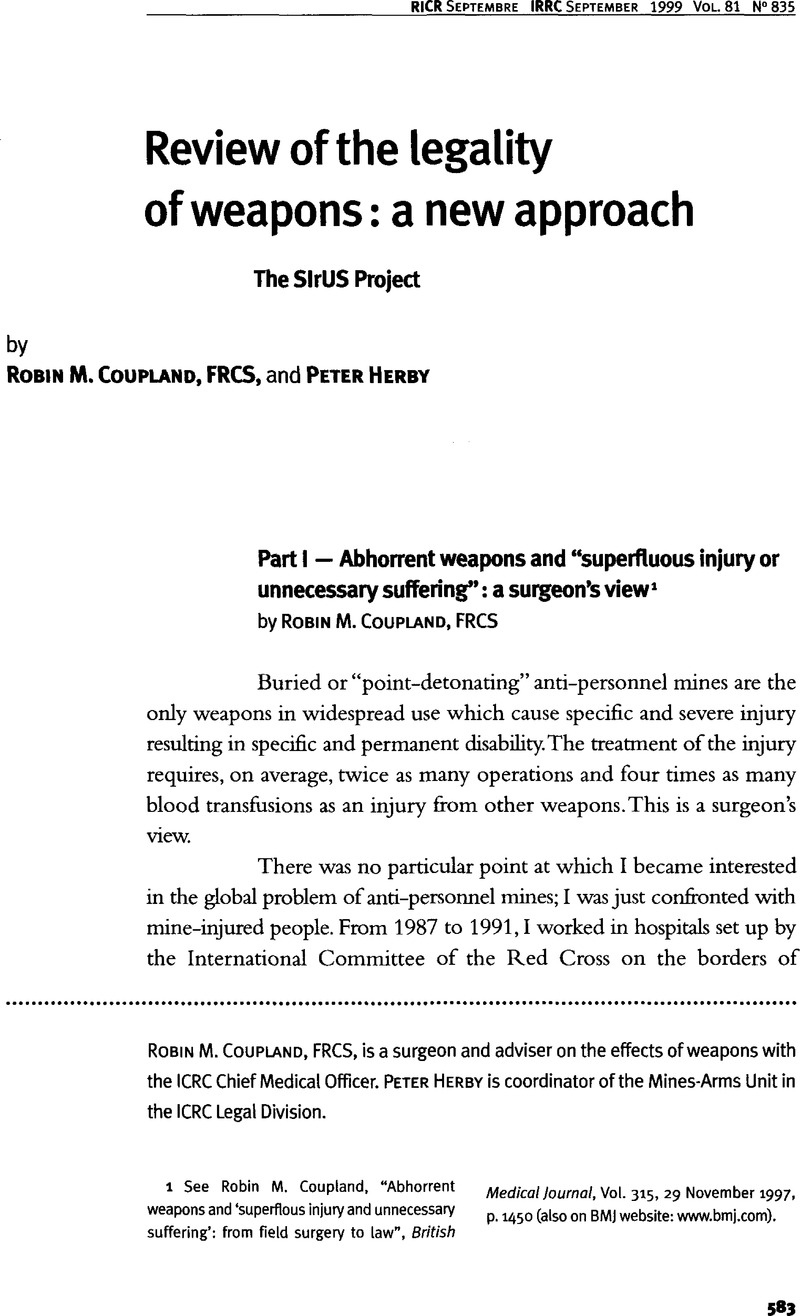Article contents
Review of the legality of weapons: a new approach
Published online by Cambridge University Press: 19 April 2010
Abstract

- Type
- Research Article
- Information
- Copyright
- Copyright © International Committee of the Red Cross 1999
References
page 583 note 1 See Coupland, Robin M., “Abhorrent weapons and ‘superflous injury and unnecessary suffering’: from field surgery to law”, British Medical Journal. Vol. 315, 29 November 1997. p. 1450 (also on BNJ website www.bmj.com).CrossRefGoogle Scholar
page 585 note 2 The Medical Profession and the Effects of Weapons, Symposium (Montreux, Switzerland, 1996), ICRC, Geneva, 1996.Google ScholarPubMed
page 585 note 3 The SirUS Project: Towards a Determination of Which Weapons Cause “Superfluous Injury or Unnecessary Suffering”, ICRC, Geneva, 1997Google Scholar.
page 587 note 1 Declaration Renouncing the Use, in Time of War, of Explosive Projectiles Under 400 Grammes Weight, St. Petersburg, 1868. Even before 1868, the ancient laws of war in India, Greece, Rome, and the Middle East had prohibited poison weapons because of their excessive effects. The 1863 Lieber Instructions: Instructions for the Government of Armies of the United States in the Field (General Orders No. 100, of 24 April 1863) also “wholly excluded” this means of warfare on the same grounds.
page 587 note 2 St. Petersburg Declaration,
page 588 note 3 In the words of Article 35, para. 2, Protocol additional to the Geneva Conventions of 12 August 1949, and relating to the Protection of Victims of International Armed Conflicts Protocol I). See also the Convention on Prohibitions or Restrictions on the Use of Certain Conventional Weapons Which May be Deemed be Excessively Injurious or to Have Indiscriminate Effects, 10 October 1980.
page 588 note 4 Legality of the Threat or Use of Nuclear Weapons, Advisory Opinion, I.C.J. Reports 1996, para. 79.
page 588 note 5 Both terms are translations from the single French concept of maux superflus contained in the 1899 and 1907 Hague Regulations Respecting the Laws and Customs of War on Land, Article 23 (e). The French text is the only authentic text of the 1899 and 1907 Hague Regulations.
page 588 note 6 This term is translated from the original French propres à causer. The term was incorrectly translated into the English “calculated to cause” in the 1907 Hague Regulations, which introduced the subjective element of the weapon designer's intention. This error was corrected when the original “of a nature to cause” was restated in Protocol I of 1977, Article 35, para. 2.
page 589 note 7 Stuart Maslen and Peter Herby, “An international ban on anti-personnel mines: History and negotiation of the ‘Ottawa treaty’”, IRRC, No. 325, December 1998, p. 693.
page 589 note 8 See Louise Doswald-Beck, “New Protocol on Blinding Laser Weapons”, IRRC, No. 312, May June 1996, p. 272 (with the text of the 1995 Protocol on Blinding Laser Weapons).
- 7
- Cited by




